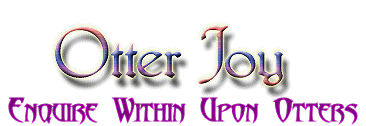Communication in the Smooth-Coated Otter
Vocal Communication
Duplaix (1980) and Maxwell (1960) are two good sources for information about this species vocalizations, particularly the latter.
Duplaix speaks of harsh nasal snorts and whines, and says they are a noisy species, with a varied repertoire of discrete social sounds. This is backed up by Maxwell's account of Mijbil, his pet smooth-coated otter of the Iraqi subspecies. Maxwell describes the call note as a short, anxious, penetrating but not loud chirp. The query is Ha! in a loud, harsh whisper. He describes a continuum through from the chirp to a musical bubbling interspersed with chirps to a high, snarling caterwaul or scream/wail preceding attack.
Non-Vocal Communication
The main form of non-vocal communication in this species is spraint, which is produced frequently. The animals create large, very smelly communal latrines at prominant sites, such as large flat rocks, comparitively high up river banks compared to sympatric Eurasian Otters.
In communication with other otters in the family group, otters seem to use their mouths as the main means of non-vocal communication, mouthing, nipping and gripping each other.| Smooth-Coated Otter |

